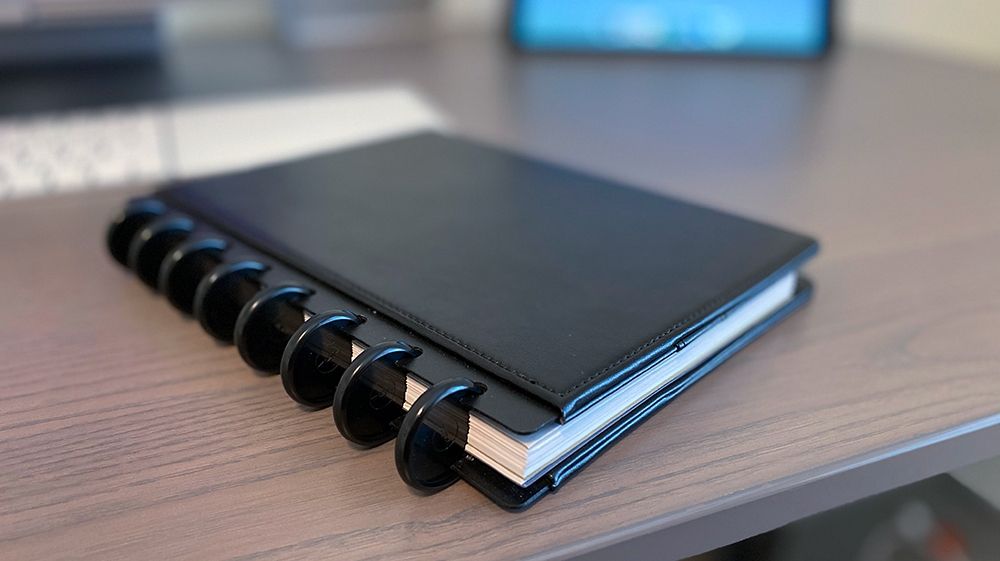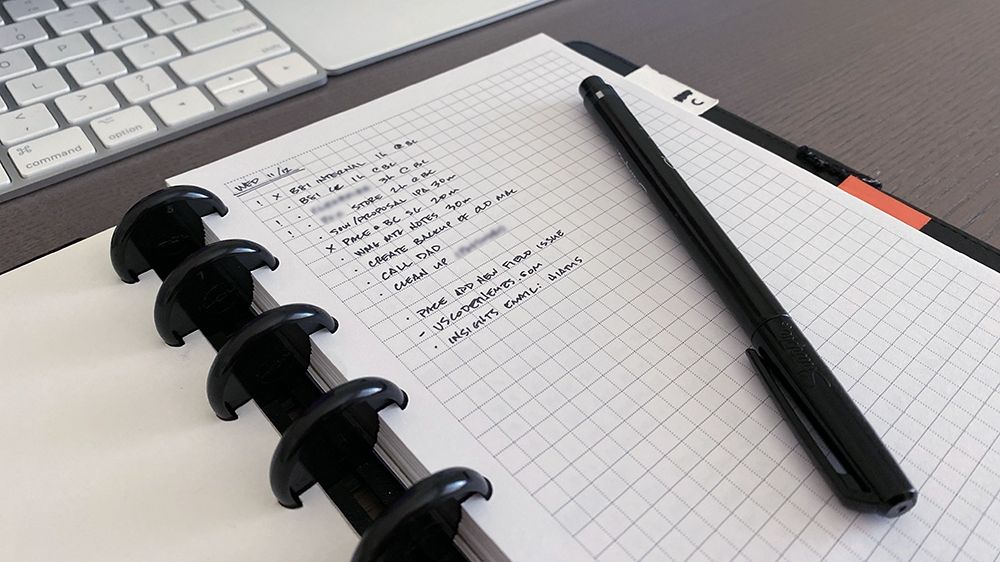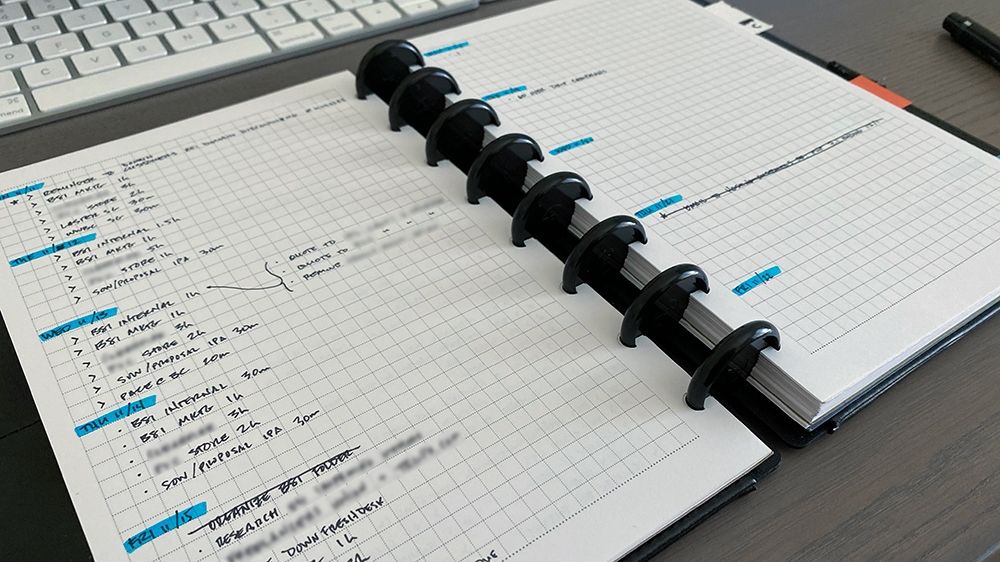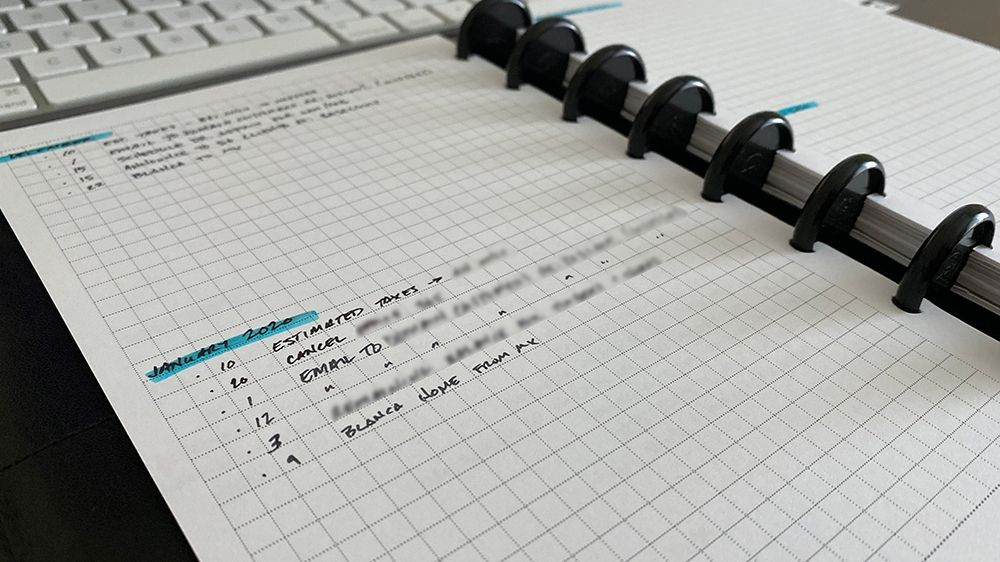How I Use My Bullet Journal As a Designer and Developer
There are plenty of "how-to" Bullet Journal articles. This one is from the perspective of a freelance designer and developer.
Update 11/2/20: This was how I used to use a Bullet Journal. I've since simplified things as outlined in this newer post, "Simplifying My Bullet Journal".
I read Getting Things Done by David Allen years ago (ten years ago now I think) and it changed how I worked quite dramatically. But I was still not quite getting enough out of it. So I stripped it down to what **did** work for me. Namely, getting everything out of my brain and writing it down, and doing at least a weekly review. I was pretty terrible with reviews and that was a big part of my problem.
I can’t remember exactly when it was that I started to get frustrated with my setup. I do remember that my frustration stemmed from things getting missed, forgotten, or would just sit there day after day in my to-do app. Without any real intention, I started using a disorganized, purpose-less hybrid of apps (yes, plural) and a paper to-do list. While I thought it was fine, it wasn’t. It was a mess.
About a couple of years ago I had had enough and decided to hunker down and start looking for ideas on a proper system of getting things done. I knew that whatever system I ended up with, it had to meet one requirement: it had to be flexible for my workflows which can vary day to day. And I was sort of hoping for an analog solution. I had had it with apps and realized I enjoyed having pen and paper next to me while working. It didn’t take too long before I came across the Bullet Journal.
I’m not going to get into what Bullet Journal is (or isn’t) – that’s best left to you to learn more about over on the official website or read The Bullet Journal Method by Ryder Carroll (the creator). What I will tell you is that it caught my attention because it was relatively simple (at least to start with) and it was created by a designer (yes, that mattered at the time for some reason 🤷).
It’s taken me several iterations of my version of the Bullet Journal, but I’ve been happily using it for a solid couple of years (possibly three) and it’s done wonders to my efficiency, time management, and overall productivity.
Why a Bullet Journal?
Frankly, because I love pen and paper. I just do. Always have. But looking beyond that, the fact is, using an app, no matter how great the app may be, I somehow feel a bit more disconnected from my work. There’s something about a tangible to-do list that you just can’t replicate in an app.
Bullet Journal also gets me to slow down. Everything becomes much more intentional. There’s a lot less speeding through things. Ironically, I get more done that way. How? One word: *friction*. It’s easier for me to eliminate things that deep down I know I won’t get to. The act of having to write it down over and over and over again is a big red flag that I’m putting off a pretty insignificant thing and have no desire to actually do it. This also means I’m forced to think about every task before I write it down. See? Intentional.
My basic Bullet Journal setup
Let me just get this out of the way: I don’t have a “standard” or “traditional” Bullet Journal setup. Part of what’s great about Bullet Journal is its flexibility; it molds to you rather than the other way around. And those intricate and decorative Bullet Journals you see when Google layouts for Bullet Journals? Awesome for those folks, but for me? Ain’t nobody got time for that.
My Bullet Journal is a discbound notebook. I discovered discbound notebooks years ago and immediately fell in love with them (though admittedly it took me a while to actually start using one). Unlike more traditional notebooks, a discbound notebook has pages with punched cutouts for the discs that allow you to add, remove, and move around the pages however you want. Yes, in that aspect they’re similar to a three-ring binder but without the ugly binder and loud noises the rings make when opening and closing. If only discbound notebooks existed when I was in high school! Nerd alert!
In any case, I use a discbound notebook for my Bullet Journal precisely because of the flexibility of moving pages around which also leads to ditching pages altogether. The “standard” Bullet Journal method sort of reveres the idea of keeping many notebooks around as you start to fill each one up. A historical look into your life, as it were. It’s a lovely thought but one I don’t really care for much. I’m a minimalist at heart – the idea of keeping a bunch of notebooks lying around (that realistically I’m probably never going to look at again) makes me shudder. (Little known fact: this is one reason that I got rid of my high school yearbooks.)

I use the junior size because it’s just the right size. I’ve tried the larger discbound notebooks but they just felt too bulky and they kind of got in my way during daily work.
I have my Bullet Journal sectioned off like so:
- daily log
- weekly/monthly hybrid log
- future log
I don’t have an “index” – I just never warmed up to the idea. And since my Bullet Journal is constantly getting pages added and removed, an index is pretty useless.
And lastly, I don’t actually “journal” in here either. Call it separation of concerns or whatever. I’ve never considered this a “journal” in the more traditional sense of the word.
Daily log
This is the section I work from every day. It’s purely for my tasks and the occasional note to remind me of some non-urgent thing later on. Events with set/confirmed times go on my calendar because duh and reminders. (That’s from the GTD method.)

I create my daily log (or task list as it were) the night before during my evening review. Doing this in the evening makes it so much easier to come into work in the morning and just dive right into work.
During my review, I start by looking at my weekly log and migrate over the tasks or projects I need to work on the next day. I then migrate any unfinished tasks from the current day. (If it’s Friday, I’m migrating things for Monday; I don’t really use my Bullet Journal on the weekends. I simply don’t carry it around and I make it a point to get away from my desk as much as possible on the weekends.)
As far as signifiers go, while mine are based on the “traditional” Bullet Journal method, I decided to keep them simple:
- “-“ for note
- • for task
- X over the • when a task is complete
- “>” over the • when a task is migrated to the next day or some future date or moved to a collection (which I don’t think I’ve actually ever done)
Monthly log (AKA the weekly/monthly hybrid log)
This is where things really start to diverge from a standard Bullet Journal. The standard Bullet Journal monthly log never made a lot of sense to me.
There seems to be a disconnect (or a misunderstanding on my part) between things that get put onto the monthly log and the daily log. Add to that the fact that for the work I do, I might have a gazillion things to do in a given month. Because of this, I started looking at weekly logs. There are a few versions out there, but none of them really worked for me. (Side note: the issues I’ve briefly described are a big reason I tried so many different ways of using a Bullet Journal and nearly gave up.)

So I came up with a weekly/monthly hybrid log. Or WMH Log for short. Okay, I totally just made that up just now. I don’t really call it that. Let’s just call it the Monthly Log – that’s what I refer to it in my head most of the time anyway.
I need to be able to write tasks more than a week in advance. But I also can’t have it as part of a big conglomeration in a traditional Bullet Journal monthly log. So I split the Monthly Log into four (or five, depending on the month) weekly logs. That way, as tasks and projects get scheduled, I can have them on specific days in the month.
At the end of each week I do a weekly review. Among the various things I do in that review, planning the next week is the most important one. That requires two things: Forecast (as explained a bit here) and my Monthly Log.
I review Forecast first because that’s where all my work projects get scheduled. For each project I will have already set when I’m supposed to work on them. So for the upcoming week, I’ll write down each of the projects I need to work on on the days I’ve set into my Monthly Log. For example, if I’ve scheduled a UI project for Monday through Thursday of the upcoming week, I’ll write down the UI project name on each of those days in the Monthly Log. (The individual tasks for a project live in Basecamp.) Because Forecast forces you to set a number of hours for a project, I make a note of that for each day too so that I don’t kill my day off by spending too much time on any one project or, worse, piling on too much on any given day.
Future log
My Future Log basically covers anywhere from six to twelve months out past the current month. I don’t put a ton of stuff in the various months of the Future Log. It’s usually stuff I know I need to do but I can’t forget about it and it doesn’t make sense to go in my calendar. A good example of this is a reminder to pay my estimated taxes each quarter.

At the start of each month (or thereabouts – it’s not *always* on the first), I migrate tasks from my Future Log to my Monthly Log. For example, let’s say we’re at the start of October. I’ll head to October in my Future Log and migrate those items to their respective dates in the Monthly Log.
Collections
For me, (custom) Collections are a bit different than they are in a standard Bullet Journal. I have three types of “things” that I keep in the Collections section of my Bullet Journal.
1. Habit tracking.
I have several habits I’m trying to stay on top of. I keep track of those in my simple habit tracker.
2. Reference.
While most of my reference-type material lives on my computer, there are a few things that I keep in my Bullet Journal. Sometimes it’s just faster for me to flip to a page than to dig through my computer.
3. Notes.
For the most part, I take notes in my Bullet Journal. They live in the Collections section until I no longer need quick access to them. When I’ve gotten what I need out of the notes (reviewed them for a project proposal, for example), I’ll scan them (using this nifty iPhone app) and archive them on my computer.
That’s all folks
That’s it. That’s how I use a Bullet Journal for my design and development work (and for non-work stuff too). Like my other posts about productivity and project management, this is what works for me. It may not work for you. But that’s the beauty of the Bullet Journal (and almost everything in life) – you can mold it to fit how you work, how you think.
I hope you’ve gotten at least something useful out of this. If you have, or if you have questions, please feel free to hit me up on Twitter!